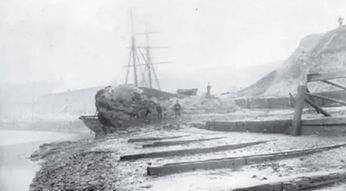Shipbuilding Archive.
SUN008
Wear
Ravens Wheel, Shipyard
Southwick
Sunderland
54.915358, -1.391402
Useful Links:
Opened:
1849
Closed:
1870
Owners:
George Barker
Types built here:
Customers (Not Exhaustive):
Estimated Output:
40
Construction Materials:
Wood
Status:
Redeveloped
Created:
10/04/24
Last Updated:
12/06/25
Description
NEHL - A shipyard stood at Ravenswheel between Wreath Quay and Southwick between 1850 and 1870.
George Barker initially, reputedly, built ships at the North Dock. This is presumable in the area directly south of it at Potato Garth. This was from around 1843, and at some point within the next few years the Barker's constructed a yard at Wreath Quay. The family were from Staffordshire, and aptly have a pottery background. His father William was a potter at Southwick, and may provide a reason why they based themselves at Wreath Quay nearby.
The yard itself is relatively modest, as seen on the Ordnance Survey of the 1850s. There were a few ancillary buildings including a smithy. Ships were likely built on the quay and pushed into the river. There was no slipway, gridiron or berth highlighted. It may also be the yard illustrated on Thomas Hair's view of Pemberton Main Colliery in the 1840s, though this would place it a few years before the first known vessel built by Barker here.
George lived at 14 Charles Street by 1854, a modestly affluent part of town. His property backed on to the noisy shipbuilding yards on the North Quay, though will still have had his own backyard and a Methodist Chapel nearby. This highlights his relative success in the trade.
He built solely cargo ships, both out of orders and for prospective buyers. His vessels travelled various routes - The Agenoria on the Sunderland to Mediterranean route and the Clyde to Rio de Janeiro route, the Ashmore from Liverpool to Vancouver and Sunderland to Bombay, and the Excelsior in Scandinavia for example. Many lasting decades until their final journey.
Barker may have been the only Victorian shipbuilder at this site. By the 1890s, Wreath Quay and Ravenswheel became a sparse industrial site. A disused cement works stood nearby, as well as the Carley Lime Works and a boat house. The Wearmouth Colliery was directly up the bank. George built his last ship, the Saint Antoine, in the same year as his death in 1870. It was a barque sold to a J Cairo of Nantes, France.
An advertisement for his yard to be let with immediate possession is shown in the Shields Gazette of 18/12/1873, for a rent of £30 per annum. This opens the question whether it went into different hands for a few years before abandonment.


Ordnance Survey, 1862
Have we missed something, made a mistake, or have something to add? Contact us
Historic Environment Records
Durham/Northumberland: Keys to the Past
Tyne and Wear: Sitelines
HER information as described above is reproduced under the basis the resource is free of charge for education use. It is not altered unless there are grammatical errors.
Historic Maps provided by




